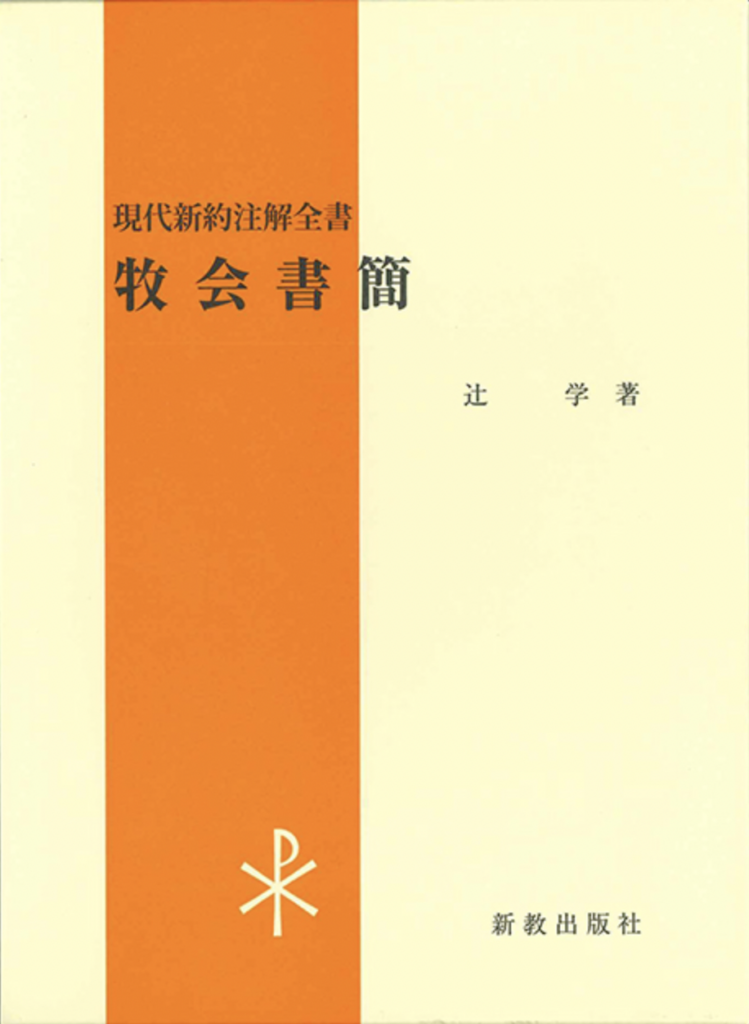
As a service to researchers in the Pastorals, we regularly note new publications that have been added to the secondary literature, and (especially through our annual bibliographies) we try to surface scholarly work in the letters that is in languages other than the relatively standard research languages of English, German, and French. My own accounting suggests there is easily as much secondary literature on the Pastorals in Italian as in French, and Polish and Dutch works are not lacking.
As many differences as there may be among, say, English, German, French, Dutch, Polish, and Italian, they are all spoken in Europe and share many similarities, not least of which is the same basic alphabet. At the time I began searching for works on the Pastorals written in Asian languages, I realized I was in a very different linguistic world. This post provides an unusual opportunity in that regard, allowing me to acknowledge a new major commentary:
Manabu Tsuji, Bokkai Shokan (Commentary on the Pastoral Epistles). Tokyo: Shinkyô Shuppansha, 2023. [Japanese]
Tsuji is Professor of Religious Studies at Hiroshima University. He holds his doctorate from the University of Berne; his dissertation was published as Glaube zwischen Vollkommenheit und Verweltlichung: Eine Untersuchung zur literarischen Gestalt und zur inhaltlichen Kohärenz des Jakobusbriefes, WUNT 2/93 (Tübingen: Mohr Siebeck, 1997). A few years back, he contributed to a list of Japanese-language scholarly articles on the Pastorals, which we posted here at pastoralepistles.com.
At 759 pages, Bokkai Shokan is a major work. Comparing page count to English works isn’t necessarily an apples-to-apples proposition, but one might think of Mounce’s 778-page WBC volume as similar in heft. Tsuji provided this summary of his work, which will give readers of the blog a good sense of where the commentary is located in the realm of Pastorals scholarship:
“This commentary consists of an approximately 60-page introduction that discusses the name ‘Pastoral Epistles,’ problems of authorship, opponents, and theological and literary characteristics, followed by nearly 700 pages of detailed exegesis and bibliography. According to the author, the three letters were written by a single author as the Corpus Pastorale, a collection of Pauline letters to individuals (Timothy and Titus) modeled after the Corpus Paulinum and intended to be read in the order of 1 Timothy, Titus, and 2 Timothy. Titus serves as a ‘spatial extension’ of the content of 1 Timothy, showing that the content of 1 Timothy is equally applicable to churches in other regions, while II Timothy serves as a ‘temporal extension,’ showing that the issue of confronting false doctrine (the main theme of 1 Timothy) remained an important concern for Paul until the end of his life. This Corpus Pastorale was written against the backdrop of conflicts over Paul’s understanding: The role of these letters is to let Paul himself speak about the ‘final correct answer’ to the questions he left unresolved or ambiguous, such as the autonomy of women and the understanding of the resurrection. The author criticizes as ‘false doctrine’ an ascetic understanding of Paul (which prohibits marriage and the consumption of certain foods). The Pastoral Epistles were written in the first half of the second century AD. Their theological characteristics (e.g., God, Christ, faith, etc.) reflect how Pauline Christianity was preached and received in the post-Pauline Hellenistic pagan world.”
Tsuji’s previous publications on the letters include the following:
“1 Tim 5:17–25: Its Context and Structure.” Shin’yakugaku Kenkyu [New Testament Studies] (Japan Society of New Testament Studies) 25 (1997): 13–24.「Ⅰテモテ 5:17–25 の文脈と構成」、『新約学研究』(日本新約学会)25 号 (1997 年)13–24 頁。[Japanese]
“II Timothy 1:6: Laying on of Hands by Paul for Ordination?” Annual of the Japanese Biblical Institute 39 (2013): 65‒76.
“Beyond the Original Context: Reception of the Pauline Letters in the First Century.” Pages 5–21 in Scrinium: Revue de patrologie, d’hagiographie critique et d’histoire ecclésiastique, vol. 6: Patrogia Pacifica Secunda: Selected Papers Presented to the Asia-Pacific Early Christian Studies Society Fifth Annual Conference (Sendai, Japan, September 10–12, 2009) and Other Patristic Studies. Edited by Vladimir Baranov, Kazuhiko Demura, and Basil Lourié. Piscataway, NJ: Georgias, 2010. = 「元の文脈を超えて――紀元一世紀におけるパウロ書簡の受容史」、『ペディラヴィウム』65号(2010年)38–56頁。[Japanese]
“‘Different teachings’ and ‘Rich Women’: On the Structure and Background of 1 Timothy 6:3–21.” Shingaku Kenkyu [Theological Studies] (Society of Theological Studies of Kwansei Gakuin University) 43 (1996): 17–38.「『異なる教え』と『富める女性』――1テモテ6,3–21の構成とその背景――」、『神学研究』 43号(1996年)17–38頁。[Japanese]
“Die Intertextualität von 1 Tim 2,1–3/Tit 3,1–2.” Pages 99–110 in Neutestamentliche Exegese im Dialog: Hermeneutik—Wirkungsgeschichte—Matthäusevangelium. Festschrift für Ulrich Luz zum 70. Geburtstag. Edited by Peter Lampe, Moises Mayordomo, and Migaku Sato. Neukirchener-Vluyn: Neukirchener, 2008. = 「Ⅰテモテ2,1–3/テトス3,1–2の間テクスト性」、『人間文化研究』第3号(2011年3月)36-48頁。[Japanese]
“Laying on of Hands by the Elders (1 Timothy 4:14) and by Paul (2 Timothy 1:6),” in: Shingaku Kenkyu [Theological Studies] (Society of Theological Studies of Kwansei Gakuin University) 51 (2004): 63–75.「長老団の按手(Ⅰテモテ4:14)とパウロの按手(Ⅱテモテ1:6)」、『神学研究』 51号(2004年)63–75頁。 [Japanese]
“On the Enrollment of ‘Widows’ (1 Timothy 5:3–16).” Shin’yakugaku Kenkyu [New Testament Studies] (Japan Society of New Testament Studies) 26 (1998): 17–29.「『やもめ』の登録 (1 テモテ 5:3–16) をめぐって」、『新約学研究』26 号 (1998年) 17–29 頁。 [Japanese]
“The Pastoral Epistles: On the Advocates of their Authenticity.” Shogaku Ronkyu [Journal of Business Administration of Kwansei Gakuin University] 50.4 (2003): 135–152.「牧会書簡――真筆性擁護の動きをめぐって」、『商学論究』 50巻4号(2003年)135–52頁。[Japanese]
“Persönliche Korrespondenz des Paulus: Zur Strategie der Pastoralbriefe als Pseudepigrapha.” New Testament Studies 56.2 (2010): 253–72. = 「パウロの個人宛書簡――偽名文書としての牧会書簡の戦略――」、『聖書学論集』43号(2011年4月)71–96頁。[Japanese]
“Saved through Childbearing: Context and Background of 1 Timothy 2:15.” Seishogaku Ronshu 41 (“Bible as Experience. Festschrift for Prof. ONUKI Takashi”) (2009): 463–79.「子を産むことによって救われる――1テモテ2:15の文脈と背景――」、日本聖書学研究所編『経験としての聖書:大貫隆教授献呈論文集』(聖書学論集41)リトン社、2009年3月、463–79頁。 [Japanese]
“Der zweite Timotheus als letzter Gefangenschaftsbrief.” Kwansei Gakuin University Humanities Review 11 (2006): 1–11. = “2 Timothy as the Last Captivity Letter.” 「獄中書簡としてのⅡテモテ書」、『新約学研究』 31号(2003年)42–55頁。 [Japanese]
“Zwischen Ideal und Realität: Zu den Witwen in 1 Tim 5.3–16.” New Testament Studies 47.1 (2001): 92–104.
